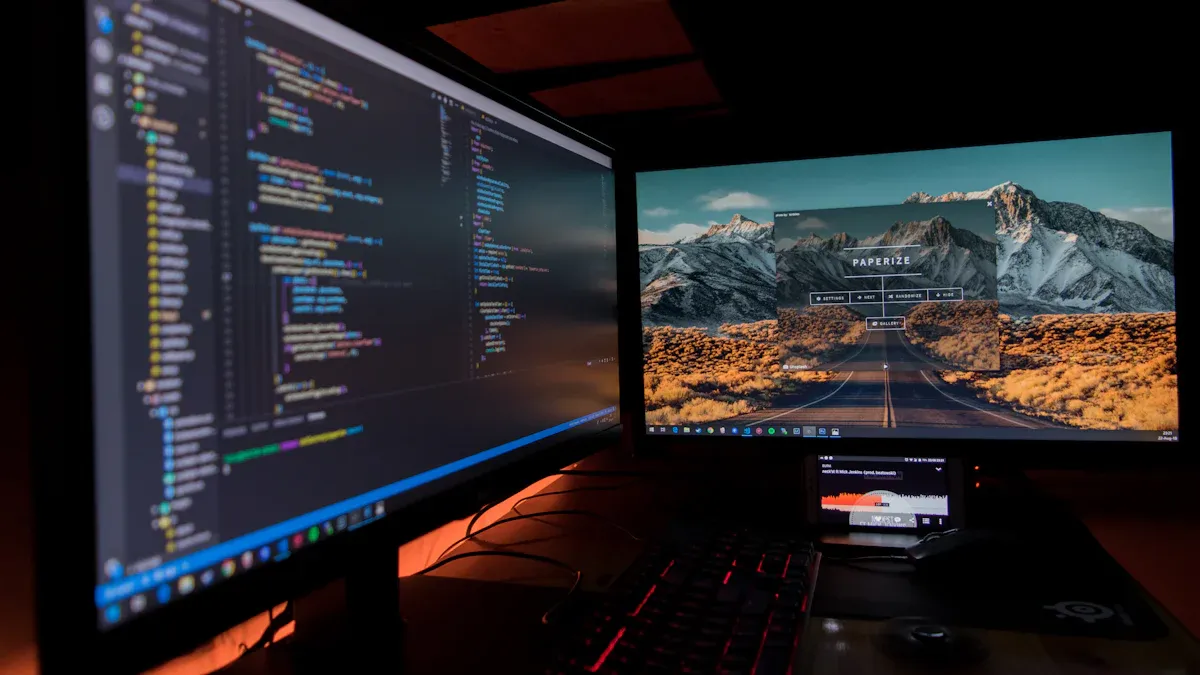What is Vibe Coding, Pros, Cons, and Should You Use It?

Imagine this: you’re sipping coffee, dreaming up the perfect app—maybe a game that goes viral or a tool that solves your daily woes. You whisper your idea to an AI, and poof! In mere minutes, lines of code materialize like magic, turning your vision into reality. No late-night coding marathons, no syntax errors to wrestle—just pure, effortless creation. Welcome to vibe coding, the hottest trend of 2025, where anyone can play tech wizard with nothing but a few words and a spark of inspiration. It’s so good, it almost feels like cheating the system.
But wait—is there anything lurking behind this shiny curtain of convenience? Let’s pull it back and see what vibe coding really brings to the table.
What is Vibe Coding?

Defining Vibe Coding
Vibe coding is a new way to make software. You just describe what you want in simple words, and the AI creates the code for you. Instead of typing hard code, you explain your idea. It’s like talking to a smart helper that turns your thoughts into working programs.
Here’s how it’s different from regular coding:
Feature | Vibe Coding | Traditional Programming |
|---|---|---|
Input Method | Simple language instructions | Writing detailed code manually |
Code Generation | AI makes the code for you | You write all the code yourself |
Focus | Sharing ideas and designs | Focusing on rules and coding details |
Accessibility | Easy for beginners to use | Needs lots of coding knowledge |
Development Speed | Fast and quick to test ideas | Slower with more time spent debugging |
This method makes coding easier for people new to it. It skips the hard parts and lets you focus on creating fun projects.
How Vibe Coding Works
Using vibe coding is very easy. Here’s how it usually goes:
Pick a tool – Choose an AI coding app that fits your project.
Explain your idea – Write what you want in plain words.
Check the output – Look at the code the AI gives you and test it.
Make changes – Ask the AI to fix or adjust the code as needed.
Share your work – Once happy, publish your project for others to see.
For example, you could say, “Make a website with a homepage, about page, and contact form.” The AI will create the code for this. You can then ask it to add colors or change the layout.
Tools for Vibe Coding
There are many tools to help you start vibe coding. Some popular ones are:
Cursor
Bolt.new
Softgen by Kortix AI
Replit
WebSparks by WebSparks.AI
Zed by Zed Industries
Aider by Aider AI
Claude Code by Anthropic
These tools are great for small projects or testing ideas. But they might not work well for big, complex systems. For larger tasks, you can try tools like Momen. It’s easier than coding from scratch and better for building strong, ready-to-use systems.
Pros of Vibe Coding

Easy for Everyone to Use
Vibe coding lets anyone make software, even without coding skills. You don’t need to spend months learning programming or fixing errors. Just explain your idea in simple words, and the AI does the rest. For example, a small business owner could ask the AI to make an app for tracking orders. No special training is needed!
This method makes software creation open to everyone. People like teachers or artists can turn their ideas into tools without hiring costly developers. Studies show vibe coding helps non-coders build useful tools, sparking creativity in many fields. It’s like having a helper that turns your thoughts into working programs.
Saves Time and Effort
Time is valuable, right? Vibe coding helps you save both. Regular coding can take weeks or months to finish a project. With vibe coding, you can get results in hours or even minutes. Imagine needing a quick draft for a new app. Instead of waiting weeks, you could have it ready by the same day.
It’s also great for quick changes. Want to fix or add something? Just tell the AI, and it’ll do it for you. This speed is perfect for startups or small businesses that need to work fast without spending too much money.
Boosts Creativity
Vibe coding isn’t just fast and simple—it’s fun for your ideas too. By skipping the hard parts of coding, it lets you focus on being creative. You can try out different designs, features, or layouts without worrying about the details. For example, you could ask the AI to make a colorful website for a school event and adjust it until it looks perfect.
This easy way of working inspires new ideas. Both coders and non-coders can come up with creative solutions that might not happen with regular coding. Plus, vibe coding uses smart tools to make user-friendly designs easier.
Still, vibe coding works best for small projects or testing ideas. For bigger, more serious tasks, tools like Momen are better. They give more control and are stronger for building reliable systems.
Cons of Vibe Coding
Problems with Code Quality
Using vibe coding can lead to messy code. AI tools focus on speed, not clean design. This can make the code hard to fix later.
Jamie Madden says, "Vibe coding is a big change... but security and performance suffer."
Some developers find it frustrating. Jo Bergum shared that vibe coding works for quick ideas but fails in big projects. You might spend more time fixing problems than creating new things.
Hard to Maintain
AI-made code can be tricky to manage over time. Why? The AI doesn’t explain its choices or logic. Later, you might not understand how the code works.
One developer said vibe coding is fast but confusing later.
Another said debugging AI code feels like solving a hard puzzle.
Experts warn that vibe coding can cause "technical debt." This means quick fixes now can lead to big problems later. It’s like building a house without strong walls—it won’t last long.
Security and Trust Issues
Security is a big worry with vibe coding. AI tools focus on working fast, not on safety. If you don’t know coding well, you might release unsafe products.
AI can create unsafe code quickly, increasing risks.
Without coding skills, it’s hard to find and fix problems.
Campbell, a developer, said vibe coding makes coding easier but less safe. Imagine launching an app without knowing its code. What if a customer wants a new feature or there’s a security issue? You’ll need to fix it fast, but vibe coding might not help.
For serious projects, try tools like Momen. They are better for control and long-term use. Vibe coding is good for small ideas, but Momen works better for big, reliable projects.
Over-Reliance on AI
Relying too much on AI for vibe coding can lead to serious problems. While it’s tempting to let AI handle everything, this approach often creates more issues than it solves. You might think, “The AI knows what it’s doing,” but does it really? Without understanding the code it generates, you could end up with a mess that’s hard to fix.
Here’s why over-reliance on AI can be risky:
AI-generated code often contains bugs or misunderstandings. If you don’t know how to code, spotting these errors becomes nearly impossible.
Some AI tools include basic security checks, but they can’t match the thorough analysis a skilled developer provides.
Many vibe coding projects lack the security needed for real-world use. Experts warn that deploying such projects in production environments can lead to vulnerabilities.
AI prioritizes functionality over safety. This means it might create code that works but isn’t secure or reliable.
“If you publish an app without understanding the code, you’re taking a huge risk,” one developer explained. “What happens when a customer asks for a new feature or a security issue pops up? You’ll need to act fast, but AI won’t always have the answers.”
Vibe coding works well for small projects or quick prototypes. It’s great for beginners who want to test ideas or learn the basics. But for larger, more complex systems, it falls short. Debugging AI-generated code can feel like solving a puzzle without all the pieces. And when things go wrong, you’ll need more than AI to fix them.
If you’re looking for a better option, consider tools like Momen. It’s designed for real-world projects, offering more control and scalability. Unlike vibe coding, Momen helps you build strong, reliable systems without the confusion of bloated code. It’s also easier to understand, making it a smarter choice for long-term success.
Should You Use Vibe Coding?
Is Vibe Coding Right for You?
Deciding if vibe coding fits your needs depends on a few things. Ask yourself these questions:
What’s your goal? Are you making a small app or a big project?
Do you know coding? Some tools are easy, others need experience.
Does the tool work with the languages or systems you use?
Can it connect well with your current tools or software?
What’s your budget? Many tools are free, but extras cost money.
Pro Tip: If your project needs strong security or long-term care, vibe coding might not be best. Use it for drafts or small parts instead.
How to Use Vibe Coding Well
To succeed with vibe coding, follow these tips:
Start simple: Use it for small tasks like testing ideas or prototypes.
Be clear: Give the AI detailed instructions. For example, say, “Make a website with a homepage and contact form.”
Check the code: Don’t trust the AI completely. Test and fix the code it makes.
Ask for better results: If the code is slow, ask the AI to improve it.
Know its limits: Use vibe coding to start, but hire a developer for long-term work.
Remember: Vibe coding helps, but it’s not perfect. You still need to understand your project.
Who Gains the Most from Vibe Coding?
Vibe coding is great for people without coding skills. Here’s who benefits most:
Non-coders: Teachers, artists, or small business owners can make apps easily.
Experts in other fields: Professionals like doctors or teachers can create tools for their work.
Beginners: New learners can build projects while learning coding basics.
Still, vibe coding isn’t for everyone. For big or secure projects, try tools like Momen. It’s better for serious work, offering more control and easier management.
Alternative to Vibe Coding
Traditional Code Development
Traditional coding is the old-school way to make software. You write all the code yourself using languages like Python or Java. This gives you full control over your project. You can make it fast, secure, and long-lasting. But it takes a lot of time, effort, and skill to do.
Here’s how traditional coding compares to vibe coding:
Aspect | Benefits of Traditional Coding | Challenges of Traditional Coding |
|---|---|---|
Control | Full control over design and code. | Needs advanced programming knowledge. |
Performance | Creates fast and efficient systems. | Takes more time than vibe coding. |
Security | Allows deep testing for safety. | Requires lots of debugging and testing time. |
If you’re making a big app or one with strict rules, traditional coding is better. It’s slower than vibe coding but more dependable for long-term use.
No Code Tools
What Are No-Code Tools?
No-code tools are platforms that let you build apps, websites, or software without writing a single line of code. Think of them as digital Lego sets: you drag and drop pre-built pieces—like buttons, forms, or databases—into place, customize them with a few clicks, and voilà, you’ve got a working product. Tools like Bubble, Webflow, and Momen are stars in this space, empowering everyone from entrepreneurs to small businesses to create polished, functional solutions. They’re designed for ease, often with visual editors and templates, so you don’t need to know Python or JavaScript to get started. By March 2025, no-code platforms have exploded in popularity, with some even integrating AI to make building smarter and faster.
Compared to Vibe Coding…
So, how do no-code tools stack up against vibe coding? While both aim to simplify software creation, they’re like cousins with different vibes. Vibe coding uses AI to generate actual code from your natural language prompts—say, “Make me a to-do list app,” and tools like Cursor or Replit churn out the scripts for you. It’s flexible and hands-on, giving you raw code to tweak or deploy. No-code, on the other hand, skips the code entirely, offering a structured, visual way to build with ready-made components. Here’s a quick breakdown:
Better Control: No-code platforms give you a clear, visual grip on your project. You see exactly how pieces fit together—no guessing what the AI spat out like with vibe coding.
Real-World Ready: Need a customer-facing app or a polished website? No-code delivers battle-tested solutions fast, like an e-commerce store on Bubble, without the messy code vibe coding might leave behind.
Easier to Maintain: Updates are a breeze—tweak a button or add a feature in minutes, no digging through AI-generated code to fix bugs or inefficiencies.
Flexibility for Features: Want to add a payment system or a user login? No-code tools often have plug-and-play integrations, making it simple to scale up without rewriting everything.
Non-Techie Friendly: For non-tech folks, no-code is a dream. Its visual logic—think “if this, then that”—makes it way easier to understand how your product works compared to deciphering vibe coding’s raw scripts.
In short, no-code tools are a powerhouse for control and clarity. They’re like having a trusty blueprint for your app, perfect for real-world projects that need to last and grow. Vibe coding might win for quick, scrappy prototypes, but no-code steals the show when you want a maintainable, feature-rich product that even your non-techie teammate can wrap their head around. Tools like Momen take it up a notch, blending AI smarts with no-code ease—giving you the best of both worlds without the chaos!
Momen
If you need a no-code tool for serious projects, Momen is a great option. It offers more control and flexibility than most no-code platforms. Unlike vibe coding, Momen creates systems that are easier to manage and understand. It’s ideal for building strong, reliable apps without messy code.
Momen is special because it balances simplicity with power. Whether you’re new or experienced, it helps you make systems that grow with your needs. If you want a tool that’s easy to use but delivers professional results, try Momen.
Pro Tip: Use Momen for projects that need to last and grow. It’s better for serious work than vibe coding.
Tips, Finally
Use AI tools, don't be used on them.
AI tools like vibe coding can feel like magic. You describe what you want, and the code appears. But here’s the thing—you can’t let the AI take over completely. You need to stay in control. Think of AI as your assistant, not your boss. It’s there to help, not to make all the decisions for you.
Here are some tips to make the most of AI tools without falling into common traps:
Understand the basics: Even if you’re using vibe coding, learn some coding fundamentals. This helps you spot errors and understand what the AI generates.
Start small: Use AI for quick prototypes or simple tasks. For bigger projects, rely on experienced developers or tools designed for scalability.
Test everything: Don’t assume the AI’s output is perfect. Run tests, check for bugs, and make improvements.
Stay involved: Always review the code. If you don’t understand it, take the time to learn or ask for help.
Think long-term: AI tools are great for speed, but they might not create production-ready code. Plan for future updates and maintenance.
Pro Tip: Industry experts recommend choosing AI tools based on in-depth analyses and real-world case studies. Look for tools with positive user feedback to ensure they meet your needs.
If you rely too much on AI, you risk creating bloated, unreliable code. Imagine launching an app without knowing how it works. What happens when a customer asks for a new feature or a bug appears? You’ll need to act fast, but AI won’t always have the answers. That’s why understanding your project is so important.
For serious projects, consider alternatives like Momen. It’s better for real-world applications because it offers more control and scalability. Plus, it’s easier to understand than raw code. Whether you’re a beginner or an expert, Momen helps you build systems that last. Use AI tools wisely, and you’ll unlock their full potential without losing control.
Vibe coding uses AI to turn ideas into code with simple words. It’s quick, creative, and makes coding easier for everyone. But it has downsides like messy code, safety issues, and struggles with big projects. If you want to try small projects or test ideas, vibe coding works well. For bigger, lasting systems, tools like Momen are better. They give more control, are easier to handle, and work for serious tasks. Always understand your project to make it successful. Use vibe coding smartly to enjoy its benefits without losing quality.
FAQ
What is vibe coding best for?
Vibe coding is great for small tasks or testing ideas. It’s helpful for beginners or people who don’t know coding. You can turn your ideas into projects easily. But it’s not good for big or advanced apps.
Can vibe coding replace traditional coding?
No, it can’t fully replace traditional coding. Vibe coding is faster and easier for non-coders. But it’s not as precise or reliable as traditional coding. For strong and secure systems, skilled developers or tools like Momen are still needed.
Is vibe coding safe for big apps?
Not really. AI-made code often misses important safety checks. This can lead to security problems. If you want to launch a public app, you should know the code or work with experts to make it safe.
Do I need to know coding to use vibe coding?
No, you don’t need coding skills to use vibe coding. You just explain your idea in simple words, and the AI makes the code. But knowing some coding basics can help you check and improve the results.
Why is Momen better for serious projects?
Momen gives more control and is easier to manage. It’s better for building strong and reliable systems. If you want a professional app that lasts, Momen is a smarter choice.
Pro Tip: Use vibe coding for quick ideas, but pick Momen for bigger, long-term projects.
See Also
Comparing Bubble, Softr, And Momen: No-Code Platforms Explored
Understanding No-Code Development Costs And Selecting The Best Platform
Evaluating The Value Of V0 By Vercel In 2025

